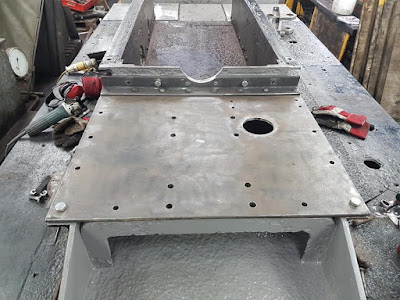Images by Rob Bishop
Although the chopper couplings were fitted some time ago, some detail aspects were incomplete. The pending gearbox re-fit will make access to the front dragbox difficult and acted as a spur to completing the couplings. Back in September 2016 the resurrection of some old, split face chopper couplings was described. The distance between the old buffer face and the coupling eccentric cam is a non-standard dimension, meaning that when coupled, the chopper faces do not meet and there is a risk that the hook may disengage due to the slack. Not too great a problem when being shunted round Boston Lodge yard but a reportable incident when the train divides in section.
The solution has been to mill part of the old buffing face off and weld on a new face plate,
bringing the buffing face to hook eccentric distance to a standard dimension.
The face of a coupling being milled off in the horizontal borer
New ‘fat face’ welded on to the cleaned up coupling
We’ve also had some cast iron bosses made to provide vertical support for the chopper coupling
and have fitted some side chains to complete the early 1929 look.
The Dragbox
While the boss castings are made to suit the modern dragbox arrangement (which has a lot of side swing), the detailing is taken from Kerr Stuart drawing 33736, ‘Arrangement of Vacuum Pipes For Diesel Loco 4415’. The new casting has a larger opening to suit the end swing of the coupling.
Behind the front buffer beam the coupling pivot on the dragbox needs the pin inserting from below as access from the top
will be impossible once the gearbox is in situ. The options however are limited. Good to get this task finished now.
Doubtless there will be new entries into the profanasaurus if that split pin ever needs taking out;
"which ****** put this together - it’s as if they put this pin in and then built the whole machine around it!!"
(They did and his name is Rob Bishop)
After closing on paint drying for the last blog entry, this time we feature hole staring; the arc of holes in the plate to the left of the dragbox is for the bolts to fasten the external gear cover to the frame (see paint drying, 11/10/18). The cover will be on the other side of the plate illustrated.





















